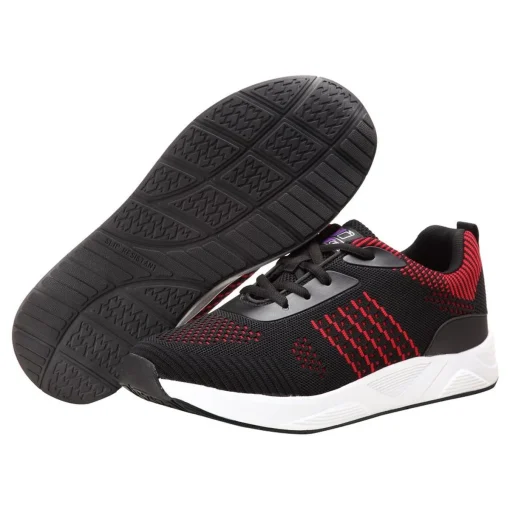If you’ve seen shoes labeled EEEE or 6E and wondered what they mean, you’re not alone. Many people only know their length size (like 9 or 10) and have never measured or considered width.
But for people with very wide feet, foot conditions, or who use orthotics, width can be just as important as length. Wearing shoes that are too narrow can cause pain, blisters, and long-term foot damage.
This guide explains exactly what EEEE and 6E mean, how wide they really are, and where you can find them if you need that extra space.
What Do EEEE and 6E Mean in Shoe Sizing?
Most men’s shoes in the U.S. are made in a standard width called D (Medium). Beyond that, width sizing uses letters to indicate increasing width: E, EE (2E), EEE (3E), EEEE (4E), and so on.
- EEEE (sometimes written as 4E) is considered extra-wide.
- 6E (also shown as EEEEEE) is even wider than 4E/EEEE, and is among the widest sizes manufactured.
Instead of increasing the length of the shoe, these letters indicate more space across the ball of the foot and toe box. A 6E shoe has a much broader forefoot than a standard or even extra-wide shoe, reducing side pressure on the foot.
How 6E and EEEE Compare to Other Widths
It’s helpful to see where 6E fits in the overall width scale. Many people think “wide” means just one size up, but there are multiple width steps.
| Width | Alternate Label | Relative Width* | Typical Fit |
| D | Medium (M) | Baseline | Average-width feet |
| 2E | EE / Wide (W) | +1 step | Slightly wide feet |
| 4E | EEEE / X-Wide | +2–3 steps | Very wide feet |
| 6E | EEEEEE / Ultra Wide | +4+ steps | Extremely wide feet, swelling, orthotics |
*Widths can vary slightly by brand, but 6E is always much wider than 4E.
While 2E or 4E may be enough for moderately wide feet, people who still feel pressure or rubbing on the sides of their feet often find relief only when moving up to a true 6E width.
How Wide Are EEEE and 6E Shoes?
Width is measured across the ball of the foot, which is the widest part. Exact measurements differ slightly by shoe size and manufacturer, but here’s a typical guide:
| Men’s Shoe Size | 4E (EEEE) Width | 6E (EEEEEE) Width |
| 8 | ~4.0–4.2″ (102–107 mm) | ~4.2–4.4″ (107–112 mm) |
| 9 | ~4.1–4.3″ (104–110 mm) | ~4.3–4.5″ (110–114 mm) |
| 10 | ~4.2–4.4″ (107–112 mm) | ~4.4–4.6″ (112–117 mm) |
Measuring your foot: Stand on paper, trace your foot, and measure the widest points. Compare to the chart. If your width exceeds what 4E allows, 6E will likely fit better.
Knowing your actual width in inches or millimeters is crucial, especially if you buy shoes online. It helps avoid guessing and saves returns.
Why You Should Consider Wider Shoes
Many people assume discomfort in shoes comes from choosing the wrong length, but often the real issue is width. Shoes that are too narrow can press on the sides of the feet, leading to pain, blisters, calluses, and even long-term problems like bunions or hammertoes. Over time, this constant compression can also restrict circulation, especially in people with conditions such as diabetes or edema.
Wider shoes, like EEEE (4E) or 6E, provide more room across the ball of the foot and toe box, reducing friction and pressure. This extra space allows the foot to sit naturally inside the shoe instead of being squeezed inward. It can also accommodate swelling, custom orthotics, or braces, which require additional volume inside the shoe.
Choosing a wider shoe can make an immediate difference in comfort, especially if you’ve struggled with sore feet or tight-fitting shoes even after sizing up in length.
Who Typically Needs 6E or EEEE Widths?
Very wide shoes like 4E and 6E aren’t just for comfort. For some people, they’re a necessity. You might benefit from 6E shoes if you:
- Have naturally wide feet that never fit standard sizes
- Experience swelling (edema/lymphedema), especially after long standing
- Have bunions, hammertoes, or diabetic foot issues causing side pressure
- Use custom orthotics or AFO braces that take up shoe space
- Have struggled with pain, calluses, or skin irritation from tight shoes
For these situations, moving from 4E to 6E can make a major difference in both comfort and foot health.
Where to Buy 6E (EEEEEE) and EEEE Shoes
Because 6E widths are highly specialized, most big-box shoe stores don’t stock them. You’ll have better luck with retailers that focus on wide and extra-wide footwear.
For example, DT Footwear’s 6E men’s collection offers a broad range of athletic, work, and casual shoes specifically made in 6E width. Browsing collections like this can help you see all your width options side by side before ordering.
Other places to check include orthopedic shoe shops, diabetic footwear suppliers, and select models from brands like New Balance or SAS that occasionally produce extra-wide sizes. Wherever you shop, be sure the listing explicitly says “6E” or “EEEEEE” rather than just “Wide” or “Extra Wide,” which can mean different things in different brands.
How to Choose the Right 6E Shoe
Getting the right width is only part of the puzzle since fit also depends on the shape, depth, and construction of the shoe. Here’s how to make sure your 6E shoes are truly comfortable:
- Measure your feet while standing (they spread when weight-bearing).
- Select your usual length size first, then match the correct width (6E).
- Look for ample toe room and no side pressure or rubbing.
- Choose shoes with removable insoles if you use orthotics.
- Opt for soft uppers and deep toe boxes to reduce friction on sensitive areas.
- Test the fit indoors and use retailers with good return policies in case adjustments are needed.
Taking these steps helps you get all the benefits of the wider width without sacrificing stability or comfort.
The Bottom Line on EEEE and 6E Widths
EEE (4E) and 6E (EEEEEE) are designations for shoe width, not length. EEEE is considered extra-wide, while 6E is even wider (among the broadest men’s shoe widths available). For reference, a men’s size 10 6E shoe typically measures around 5.4–5.6 inches across the ball of the foot, though exact measurements can vary slightly by brand. These widths provide significantly more space across the ball of the foot and toe box than standard D or even 2E widths.
If your feet feel cramped, sore, or pressured on the sides even in “wide” shoes, it likely means you need a wider size, not a longer one. Measuring your foot width can confirm this, and choosing the right width helps prevent pain, friction, and long-term foot problems. Shoes in EEEE and 6E widths are usually found through specialty retailers or orthopedic footwear brands rather than general shoe stores, so it’s important to look for listings that specifically state 4E or 6E.
In short, understanding what EEEE and 6E mean and knowing how wide they are takes the guesswork out of shoe shopping. Choosing the right width ensures your shoes fit comfortably, protect your feet, and make every step easier.

